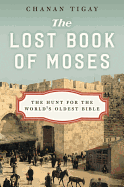
In 1883, a Jerusalem antiquities merchant named Moses Wilhelm Shapira offered to sell the British Museum what he claimed was an ancient copy of Deuteronomy for the breathtaking sum of £1 million (about £110 million, or $160 million, today). After initial popular and scholarly excitement, the scrolls were dismissed as frauds. Shapira committed suicide soon after, and his scrolls disappeared.
Israeli journalist Chanan Tigay first heard the story of Shapira's scrolls in 2010. The tale caught his imagination, especially when he learned that Shapira's manuscripts were strikingly similar in form and reputed provenance to the Dead Sea Scrolls, the discovery of which six decades later had fundamentally changed Biblical scholarship. A small group of scholars had come to believe that Shapira's scrolls might have been authentic. But without the scrolls themselves, no one could know.
The Lost Book of Moses: The Hunt for the World's Oldest Bible tells the story of Tigay's attempt to locate Shapira's missing scrolls, a four-continent, 15-year trail of red herrings, unexpected leads and repeated dead ends that led him to academic archives, antiquarian booksellers, museum storerooms, a hotel attic and a surprising number of Anglican church services. Tigay places his search against the background of not only Shapira's life, but also the broader context of the economic revival of Ottoman Jerusalem in the 19th century, venomous rivalries in the developing fields of Middle Eastern archeology and biblical textual criticism, and the art of faking antiquities.
The Lost Book of Moses is half treasure hunt, half research project, and wholly engaging. --Pamela Toler, blogging at History in the Margins

